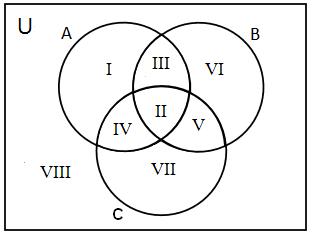Question
Let A, B, and C be subsets of a universal set U, as in the diagram to the right. Use the information given below to
Let A, B, and C be subsets of a universal set U, as in the diagram to the right.

Use the information given below to determine the number of elements in each numbered region.
n(A) = 29, n(B) = 45, n(A ∩ B) = 8,
n(C ∩ B) = 20, n(C ∩ A) = 17,
n(A ∪ B ∪ C) = 80, n(A ∩ B ∩ C) = 3,
n((C ∪ B)') = 22
Enter the number of elements in each region, in order, separated by commas.
A B III VI II IV VIII VII
Step by Step Solution
3.43 Rating (172 Votes )
There are 3 Steps involved in it
Step: 1
Given nA 29 nCA 17 nB 45 nABC 80 nAB 8 nABC 3 nCB 2...
Get Instant Access to Expert-Tailored Solutions
See step-by-step solutions with expert insights and AI powered tools for academic success
Step: 2

Step: 3

Ace Your Homework with AI
Get the answers you need in no time with our AI-driven, step-by-step assistance
Get StartedRecommended Textbook for
Introduction To Mathematical Statistics And Its Applications
Authors: Richard J. Larsen, Morris L. Marx
5th Edition
321693949, 978-0321694027, 321694023, 978-0321693945
Students also viewed these Mathematics questions
Question
Answered: 1 week ago
Question
Answered: 1 week ago
Question
Answered: 1 week ago
Question
Answered: 1 week ago
Question
Answered: 1 week ago
Question
Answered: 1 week ago
Question
Answered: 1 week ago
Question
Answered: 1 week ago
Question
Answered: 1 week ago
Question
Answered: 1 week ago
Question
Answered: 1 week ago
Question
Answered: 1 week ago
Question
Answered: 1 week ago
Question
Answered: 1 week ago
Question
Answered: 1 week ago
Question
Answered: 1 week ago
Question
Answered: 1 week ago
Question
Answered: 1 week ago
Question
Answered: 1 week ago
Question
Answered: 1 week ago
Question
Answered: 1 week ago
View Answer in SolutionInn App



